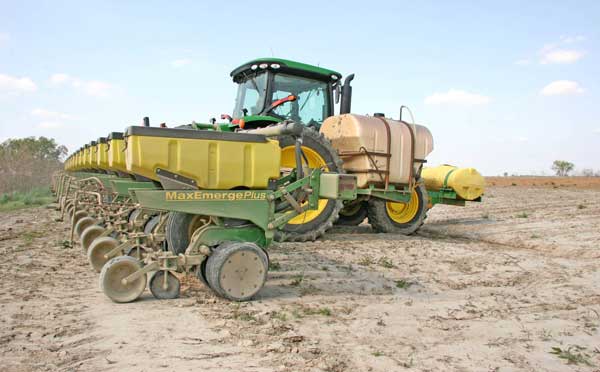April 23, 2012

With the 2012 cotton planting season just around the corner producers should take time to make certain that planting equipment and procedures are in place, says Dr. Randy Boman, Oklahoma State University Research Director and Extension Program Leader.
Ample rainfall and a warming trend, Boman says, could mean cotton farmers will be anxious to start planting by late April.
"Cotton producers should be considering basic maintenance issues, especially for planters,” he says. “It is important to double check planter bearings, discs, chains, vacuum systems and plates to make sure everything is in excellent working condition. Badly-worn parts should be replaced to contribute to planting precision. Seed tubes can be plugged due to insects and trash accumulation. It is a good idea to make sure delivery tubes are clean and flowing freely.
He says planter adjustment is something of “an art. Each field should be assessed, and, as many producers are aware, even the soil and moisture variability in a given field can result in planter adjustment concerns. Soil moisture (good seed to moist soil contact) level is critical in the zone immediately surrounding the seed. If too much dry soil is removed from the planting zone, hard crusting or 'baking' behind the planter can occur, especially if high temperatures, wind and low humidity are a challenge at planting time.”
Modern planters are less likely to have that baking issue, he says, although it may be a concern in some instances. “Seed should be planted in good moisture, probably not more than two inches deep, depending on the seed vigor, wind and heat forecast. Dry soil in the seed furrow or incomplete closing of the seed furrow may result in highly variable stands when difficult environmental conditions are encountered.”
Planting time target
Boman says a good planting target includes a soil temperature of 65 degrees at the four inch depth. “The Mesonet provides this information: http://agweather.mesonet.org/index.php/data/section/soil_water.”
Boman says producers recognize that cotton seedlings can be damaged by cool, wet soils. He recommends delaying planting under normal soil moisture conditions until (1) the three-day Mesonet soil temperatures at the four-inch depth are at least 65 degrees.
(2) The five day forecast calls for dry weather and a minimum of 25 to 50 DD60 heat units. The normal calculation for daily cotton DD60 heat units is: ((maximum air temperature + minimum air temperature)/2)-60. “Essentially, the average air temperature for the day is determined and the 60-degree developmental threshold for cotton is subtracted. The DD60s for each day are then totaled. If you have faith in your local forecast, the projected high and low for the following several days can be used to calculate future DD60s.”
And (3) “Low temperatures are forecast to remain above 50 degrees for the five days following planting. Because of planting window constraints arising from the number of planters and acres to cover, this can be a nearly impossible goal.
"Even if planted into reasonably good moisture, growers should watch fields for moisture loss in the seed zone, especially if high winds and heat follow planting. If producers expect to follow planting with center pivot irrigation, the seed should not be placed more than one and-a-half inches deep. Make sure seed is covered well with soil.”
Stand, Boman says, is important for both uniformity and density. “Uniformity of planting seed in the row is affected by planter type,” he says. “The newer vacuum planters are extremely effective in controlling vertical distribution of the seed in the seed furrow and with horizontal spacing down the row. Modern planters typically provide excellent seed-to-soil contact capability.
“Seeding rate or density is controlled by the producer. The newer vacuum planters coupled with seed quality that’s generally higher than we often encountered in the past allows most producers to reduce seeding rates.
"However, because of the cost of transgenic varieties in addition to cost of insecticide seed treatments, many producers are pushing the agronomic minimum and living on the edge with little margin for error,” Boman says.
“Results of many seeding rate trials have been conducted in southwestern Oklahoma and the Rolling and High Plains regions of Texas for the last several years all show that seeding rates can be pushed to a lower level than what was generally accepted 10 to 15 years ago. However, producers must have extreme trust in their planters, field-specific planting situations, seed quality and environmental conditions after planting. It is difficult to justify, agronomically, less than two seed per row-foot as a best management practice for dryland cotton production."
TALKIN' COTTON is produced by NTOK Cotton, a cotton industry partnership which supports and encourages increased cotton production in the Rolling Plains of North Texas, Oklahoma and Kansas. For more information on the cotton scene, see ntokcotton.org and okiecotton.org. For comments or questions about Talkin' Cotton, contact [email protected].
You May Also Like




